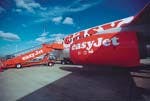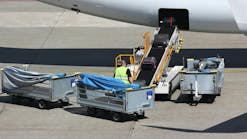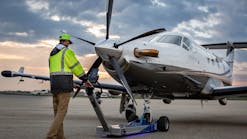Many European secondary airports are showing signs of healthy growth, fuelled by the low-cost airline boom and the success of regional jets. Ground handlers are having to adapt quickly as competition increases along with the numbers.
October 2004
The remarkable surge in low-cost airline traffic has changed the European airport landscape. Usually preferring secondary airports for their lower charges and slot availability, airlines such as easyJet and Ryanair, have opened up new markets for passengers and aviation companies alike.
While soaring oil costs and a bitter price war is affecting current profitability, the general trend for these airlines, and the airports they serve, is a steep upward curve.
A prime example is UK-based easyJet, whose 50 or so destinations include the likes of Liverpool, Marseilles, Naples and Dortmund. In August 2004 the airline carried 2.46 million passengers, up 24 percent over the corresponding period last year, while load factor climbed to 88.6 percent.At Liverpool John Lennon Airport, easyJet is by far the dominant carrier, accounting for more than 80 percent of traffic. "It seems amazing that in one month easyJet carried almost 250,000 passengers via Liverpool when only a few years ago twice that amount passed through the Airport on all services in a whole year," notes Neil Pakey, the airport's managing director.
Ryanair - which soon expects to celebrate its 100 millionth passenger - also serves Liverpool and recently introduced service to Rome from the 2008 European Capital of Culture. Together with easyJet and other new, short-haul airlines such as VLM, Emerald Airways and Aer Arann, the Irish carrier helped propel Liverpools passenger numbers to more than 328,000 in July, an increase of 11 percent over the same period in 2003.
Solid though the growth is, this is still only about the average for ACI-Europe's Group 4 airports (those with less than 5mppa - million passengers per annum), which show a 10 percent increase in June 2004 over June 2003, higher than the first three, larger airport groupings.
Some airports, however, are far outstripping even these numbers. Eindhoven Airport in the Netherlands, for example, has reported a massive upsurge - passenger numbers grew by 54 percent in the first six months of 2004, with Ryanair's new services to Barcelona as the driving force.
Germany's Cologne/Bonn Airport, has likewise recorded a 43 percent increase in passengers for 2003, largely provided by low-cost operators Germanwings and Hapag-Lloyd Express. Over half of its 7.84 million passengers flew with a low-cost carrier.
Michael Garvens, airport CEO, commented: "Deep-seated changes in the airline industry are demanding a radical new approach by airports to traffic, profit and cost structures. We plan to continue the process of enhancing our traffic mix with an eye to the future, while markedly reducing costs and tapping into new income streams."
Positive Impact
Inevitably, such 'deep-seated changes' do not only affect the airports, but all aviation companies providing the associated infrastructure. Ground support companies, for example, may delight in strong growth on the one hand but, on the other, face an ultra-competitive environment, forcing a downward pressure on charges.
"The arrival on the market of low-cost airlines has had a positive impact on our business," says president & CEO of the Aviapartner Group, Alex Verougstraete. "They are becoming an increasing part of our portfolio. Low-cost airlines ask for a more basic and standardized product - such as common check-in or no cleaning -which does mean lower tariffs, but this is usually compensated for by volume."
One of Europe's leading independent ground handlers, Aviapartner is headquartered in Belgium. The group offers a wide portfolio of airport services including passenger and baggage handling, ramp services and aircraft servicing and maintenance at 32 airports in Belgium, France, Germany, the Netherlands, Italy and Switzerland. In all, Aviapartner works with over 250 airlines and in 2003 served 19.7 million passengers, provided ramp services for more than 183,000 aircraft and handled 770,000 tons of cargo.
"The market situation at the airports where we operate depends on the local traffic at each given station and on how tough the competitive environment is," Verougstraete continues. "In some airports, we are faced with fierce competition, leading to a strong pressure on tariffs. Nevertheless, we can proudly say that for two years in a row now, we have been able to increase our market share in most airports we serve."
Verougstraete also reports tariffs being impacted by the increased penetration of new generation regional jets (RJs). The low operating costs and adaptable cabin arrangements they offer are perfect for developing niche point-to-point markets in the European arena. "The increased use of regional jets has an impact on our business as handling tariffs are not the same for smaller types of aircraft as for jumbo jets," he says.
Dense Network
Downward pressure on tariffs is not the only challenge an aviation organization
in the European market must overcome. It must also be equipped to deal
with the huge variety of aircraft, from RJs through single-aisle workhorses
like the Boeing 737 or Airbus A320 to long-haul wide bodies.
Purchasing and maintaining the equipment necessary for such a variety of needs makes it difficult to find a cost-effective business model. "The purchase of ground support equipment represents a big part of our operating costs," agrees Verougstraete. "We indeed need to have all the equipment available for all the types of aircraft we have to handle at a given airport. Our GSE management is done centrally," reveals the President. "Our dense network gives us a competitive advantage of being able to easily shift equipment from one station to another - when business gets slower at one station and increases at another for example, or specifically for a start-up."
Staffing likewise has to be planned strategically, according to need and Verougstraete admits it is 'a crucial element of our business.' The organization has to adapt to the use not only of different types of aircraft but also different requests from airline customers and the possibility of flight delays or cancellations.
Of course, if it couldn't be done cost-effectively it wouldn't be done at all. "We have specialized software at our disposal for price calculations," Verougstraete notes, "which takes into account personnel and equipment cost. These costs are of course spread out over several customers. When we start operations in a new station, or we want to purchase special GSE, we usually count on the fact that extra customers will soon start supporting these costs."
Interfacing With Customers
Specialized software is in fact a vital component in ground support success in this type of market. Aviapartner, for example, pours a lot of resources into its centralized in-house IT department, which comprises around 45 dedicated specialists, developing and supporting tailor-made IT systems, which the company uses throughout its network.
The concept is to create a win-win scenario. Customers benefit from improved and more timely service while Aviapartner increases productivity, cancelling out the damaging effects of continued pressure on handling tariffs.
"Our approach is to give interfacing with customer systems our prime attention, whether for check-in systems or for our cargo automation system," comments Verougstraete. "This way our people only need to learn one system, which reduces the risk for errors and increases efficiency. Our state-of-the-art integrated IT systems have been designed - sometimes fully developed in-house, sometimes based on an existing package - to support our various handling services online and in real time, including planning and rostering of personnel and so on, up to invoicing," he adds.
Aviapartner's IT challenge for the future is to adapt its systems and processes to the increasing trend of automation. IATA (International Air Transport Association) has announced a four-pronged Simplifying the Business campaign, which includes 100 percent e-ticketing, increased use of common-use self-service kiosks, RFID baggage tags and a bar code standard for boarding passes. Cargo is similarly pushing for electronic airway bills.
Looking Ahead
Verougstraete sees other hurdles to overcome as well, in what is turning
into a lucrative, if competitive, environment. Airline alliances are one
example, as the groupings have the power to distort the normal mechanics
of the market. The Aviapartner CEO remains upbeat, however, preferring
to see them as "also an opportunity, because we are one of the few
handling networks capable of offering global packages."
The company also faces the challenge of the equipment itself but plans to continue influencing design, its varied needs in this vibrant market always pointing it in new and innovative directions. "Most existing GSE suppliers offer an acceptable price/quality ratio, " Verougstraete believes. "At Aviapartner we work as partners in close cooperation with our preferential suppliers. We continuously inform them of our increasing needs, on problems we had, on possible improvements and recommendations.A supplier who is not open to that, who is not prepared to listen to our needs and take them into account will not remain a preferential supplier for much longer," he warns.
But whatever obstacles may lie in wait, the road to success in small European airports stretches unbroken. Growth is phenomenal and the list of underserved regional airports is far from exhausted. Companies involved in the sector will doubtless continue striving for expansion, improving market share in existing airports and looking for new opportunities.
One big temptation will be the new EU member states of Eastern Europe. Airports such as Prague and Riga are already blossoming into popular low-cost destinations and posting huge percentage increases in passenger traffic. Competition may be fierce and tariffs may be low but the European secondary airport market has enough potential to make it all worth it.





